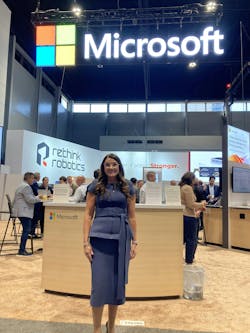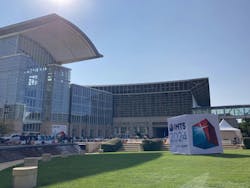Maintenance Mindset: Why smart manufacturers are investing in AI — and you should too
Today's Maintenance Mindset column is an interview I conducted about a month ago at the IMTS trade show in Chicago, where I was able to talk with Kathleen Mitford, the corporate vice president of global industry marketing at Microsoft. She works with both customers and partners on making Microsoft Cloud relevant for industries to help customers to solve their business problems. Before joining Microsoft, Mitford worked on the executive team at PTC, most recently as their chief strategy officer, helping PTC evolve from an on-prem company to a SaaS-first company.
PS: How was your keynote this morning? What were some of the points that you led off with about how smart manufacturing and Microsoft see the future developing?
KM: Just like you and many others, I've been in and around the industrial space for a long time, and I have never seen innovation moving at the pace that I'm seeing right now. If you think about it, over the last decades, there are different types of technologies that customers have been implementing. You mentioned some of them, things like cloud infrastructure, managing data at the edge, IoT, digital twins. These have been implemented over the last 10 years in bits and pieces, but maybe some customers didn't actually see the full return that they were hoping to get of all of these investments together.
Well, now's the time. This is where we're really starting to see customers get return out of those investments that they've made, because if you think about AI, AI needs the foundation of all of these technologies that have been implemented over the last couple of years, so I am seeing a pace of adoption of AI at a rate that I have not seen in my career in the tech industry of a little bit over 30 years.
We see AI is happening now, it's impacting customers’ businesses now. In fact, I said this morning that if you haven't started already, you're late.
PS: Do you see any part of the business being impacted before the others? I'm accustomed to hearing a lot of stories about companies focusing on downtime issues first because the cost per hour of downtime is an easily quantified number, and they work with the reliability teams, the operations teams to try and minimize that unplanned downtime. Do you see that as being a primary focus for these smart technologies, or more operational, or financial?
KM: It really depends upon the company. What I encourage companies to do when I'm engaging with them and their boards is to think about what’s going to have the biggest impact to your business.
We do see a lot of focus on what can we do to reduce unplanned downtime, and also to do predictive maintenance. We've been talking about these for years, but I see that actually being implemented today. In fact in my keynote, I talked about Bridgestone, and that was exactly what they were looking to do, is to see how they could reduce unplanned downtime. Because today whenever they had an issue, whether it was downtime or quite frankly just a bottleneck in their production line, to figure out what was actually happening it would take a manufacturing engineer and expert hours and hours, typically up to four hours, to go through all of their production process data, to go through all of their system monitoring data, to pinpoint exactly what was causing that particular challenge.
So Bridgestone partnered with Microsoft and with our partner Avanade to use a copilot. They're using this copilot, which is like having the expert sitting right next to you. So instead of spending the four hours looking through all the data, just saying, “Copilot, help me figure out what's causing this slow down in production” and then getting them not only to what is the root cause of the issue, but then what are the steps that needs to be taken to resolve it.
That's an example of how can we use this AI technology today to help us make our factories run more efficiently. That's one example that I see happening a lot, where we've got so much data, think about all the data coming from the factory floor, and pinpointing those issues.
Another area where I do see a lot of investments in AI is on how do we make our frontline workers more productive. You know, a similar type of use case is, now that we know where the issue is – maybe there's an acid on the floor that needs some type of repair, but you don't have the expert worker that you know is there and who knows how to do the repair that is required – so also using AI to not only diagnose what the issue is, but then also to give step by step instructions to the frontline worker so that they can they can address it without having to go through tons of manuals to have to figure out the root cause and the instructions to fix it.
PS: What are customers saying, beyond Bridgestone?
KM: One of my favorite stories is in fact just earlier this morning, I was sitting with the CEO of Harding. Harding is using AI to help them create custom designs for their customers. You're familiar with their product line, they make the electric connectors and network components, and the majority of the products that their customers request are custom. It would take a CAD engineer hours to sort through what they have in their library and then to be able to put the pieces together to create the CAD model that meets that customer’s requirement.
So Harding partnered with Siemens and is using generative AI so that the CAD engineer just needs to either talk like I'm talking, in natural language, or type into the system what are the customer’s requirements, and then it will go and automatically create a CAD model with the required precision.
So if you think about that, before using AI – and actually the CEO and I were talking about this on the impact on his engineers – is think about how much time it would take, and then also think about the potential of not using inventory, that they may miss pieces that are existing we have they have in inventory. So they're seeing tremendous benefit for their engineers and their team to be able to save them time, and then you know really importantly for that engineer to focus on things that give him joy. It's taking out some of the mundane tasks and automating it for them.
It also allows them to be able to respond to more customer requests faster as well. That's an example that I get pretty excited about. Just think about how AI is changing the engineering processes, it's changing what we're doing in the factory. It's actually finally making our factories smart factories. And then it's also having an impact on the field, with the example that I used for maintenance, being able to give step-by-step instructions.
PS: Whenever someone asks, “where do you think the next generation is going to come from?” I think they're going to start with software, and then move toward maintenance and reliability. I'm curious to know what your perspective is on this next generation moving into factories.
KM: I actually love it that you are talking about that, because I like to talk a lot about how technology is making manufacturing sexy again. For years there, manufacturing was seen as a place that's not where the cool kids were. Well, the cool kids now are in manufacturing, and a lot of that is because of the technology.
Think about these great innovations that you can use. We just talked about all these different examples of AI for auto-generating product designs for you, AI helping you to automate your factory and find out where the problems are, AI helping you to be able to diagnose and show you how to repair something.
People are used to using technology in their home life, experiential technology, and with all of this technology that's come into the manufacturing space, I think it's really helping us to get younger kids interested in getting into manufacturing, to want to work on a factory floor, to want to be a maintenance or a service technician because you get to use the latest tech, and it's also advancing at a pace that is so fast.
AI is happening now. We are seeing customers adopt AI across all different areas of the value chain, from engineering to manufacturing to service, and getting value out of the investments that they've made, and Microsoft is committed to working with our customers and our partners on moving their AI transformations forward.



